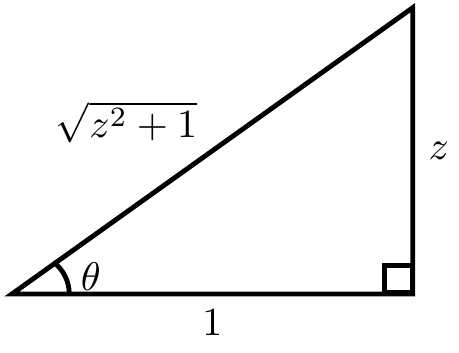Difference between revisions of "Derivative of arctan"
From specialfunctionswiki
(Created page with "<div class="toccolours mw-collapsible mw-collapsed"> <strong>Proposition:</strong> The following formula holds: $$\dfrac{\mathrm{d}}{\mathrm{d}z} \mathrm{arctan}(z) = \dfrac{1...") |
|||
| (4 intermediate revisions by the same user not shown) | |||
| Line 1: | Line 1: | ||
| − | + | ==Theorem== | |
| − | + | The following formula holds: | |
$$\dfrac{\mathrm{d}}{\mathrm{d}z} \mathrm{arctan}(z) = \dfrac{1}{z^2+1},$$ | $$\dfrac{\mathrm{d}}{\mathrm{d}z} \mathrm{arctan}(z) = \dfrac{1}{z^2+1},$$ | ||
where $\mathrm{arctan}$ denotes the [[arctan|inverse tangent]] function. | where $\mathrm{arctan}$ denotes the [[arctan|inverse tangent]] function. | ||
| − | + | ||
| − | + | ==Proof== | |
| + | If $\theta=\mathrm{arctan}(z)$ then $\tan \theta = z$. Now [[implicit differentiation]] with respect to $z$ yields | ||
$$\sec^2(\theta)\theta'=1.$$ | $$\sec^2(\theta)\theta'=1.$$ | ||
The following triangle shows that $\sec^2(\mathrm{arctan}(z))=z^2+1$: | The following triangle shows that $\sec^2(\mathrm{arctan}(z))=z^2+1$: | ||
[[File:Sec(arctan(z)).png|200px|center]] | [[File:Sec(arctan(z)).png|200px|center]] | ||
Substituting back in $\theta=\mathrm{arccos(z)}$ yields the formula | Substituting back in $\theta=\mathrm{arccos(z)}$ yields the formula | ||
| − | $$\dfrac{\mathrm{d}}{\mathrm{d}z} \mathrm{arccos(z)} = \dfrac{1}{\sec^2(\mathrm{arctan(z)})} = \dfrac{1}{z^2+1}. █ | + | $$\dfrac{\mathrm{d}}{\mathrm{d}z} \mathrm{arccos(z)} = \dfrac{1}{\sec^2(\mathrm{arctan(z)})} = \dfrac{1}{z^2+1},$$ |
| − | + | as was to be shown. █ | |
| − | + | ||
| + | ==References== | ||
| + | |||
| + | [[Category:Theorem]] | ||
| + | [[Category:Proven]] | ||
Latest revision as of 13:05, 22 September 2016
Theorem
The following formula holds: $$\dfrac{\mathrm{d}}{\mathrm{d}z} \mathrm{arctan}(z) = \dfrac{1}{z^2+1},$$ where $\mathrm{arctan}$ denotes the inverse tangent function.
Proof
If $\theta=\mathrm{arctan}(z)$ then $\tan \theta = z$. Now implicit differentiation with respect to $z$ yields $$\sec^2(\theta)\theta'=1.$$ The following triangle shows that $\sec^2(\mathrm{arctan}(z))=z^2+1$:
Substituting back in $\theta=\mathrm{arccos(z)}$ yields the formula $$\dfrac{\mathrm{d}}{\mathrm{d}z} \mathrm{arccos(z)} = \dfrac{1}{\sec^2(\mathrm{arctan(z)})} = \dfrac{1}{z^2+1},$$ as was to be shown. █
